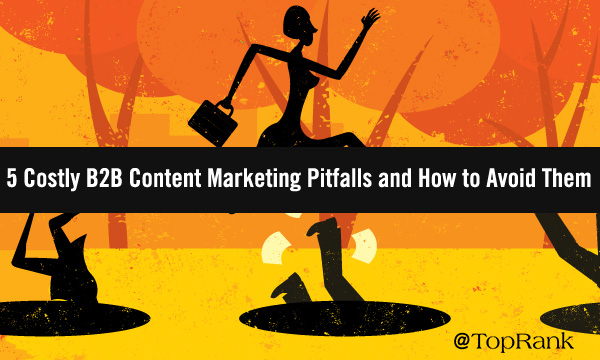
 It’s been almost 40 years since Pitfall!, the classic side-scrolling platformer for the original Atari, was first released. David Crane’s creation went on to become one of the first console video game hits, selling more than 4 million copies, and is now remembered as an influential breakthrough for the medium. Why did Pitfall! gain such rampant popularity? Because it was realistic and relatable! I’m not talking about the pixelated 2D graphics or exotic jungle setting. I’m talking about the basic premise of problem-solving. The game is full of traps, hazards, and challenges, but there’s always a way around them. “Oh hey, a giant pit full of alligators. How will I get to the other side? Perhaps by grabbing hold of that swinging vine…” via Gfycat Today’s B2B content marketers may feel like they’re navigating a landscape filled with pitfalls — dangers or difficulties that are easily encountered but not immediately obvious. To help you on your journey, we’ve identified five of the most pervasive pitfalls so you can spot them and avoid them.
It’s been almost 40 years since Pitfall!, the classic side-scrolling platformer for the original Atari, was first released. David Crane’s creation went on to become one of the first console video game hits, selling more than 4 million copies, and is now remembered as an influential breakthrough for the medium. Why did Pitfall! gain such rampant popularity? Because it was realistic and relatable! I’m not talking about the pixelated 2D graphics or exotic jungle setting. I’m talking about the basic premise of problem-solving. The game is full of traps, hazards, and challenges, but there’s always a way around them. “Oh hey, a giant pit full of alligators. How will I get to the other side? Perhaps by grabbing hold of that swinging vine…” via Gfycat Today’s B2B content marketers may feel like they’re navigating a landscape filled with pitfalls — dangers or difficulties that are easily encountered but not immediately obvious. To help you on your journey, we’ve identified five of the most pervasive pitfalls so you can spot them and avoid them.
5 Pitfalls in B2B Content Marketing & How to Steer Clear
From messaging to strategy to execution, these are five of the most counterproductive missteps that are commonly made by modern content marketing practitioners. 1 — Speaking to the Many Instead of the Few If you’re talking to everybody, you’re talking to nobody. This is a critical guiding philosophy, which may run counter to the way many marketers and writers were trained. (Especially those with backgrounds in journalism or media.) There’s a natural compulsion to make B2B content as accessible and broadly applicable possible, in order to maximize the potential reach. But with so much information and so many resources at the fingertips of today’s decision makers, marketers need to get more specific and direct. Joel Goobich of Vestorly called out “vague, generalized content” at the top of his recent list of B2B content marketing mistakes shared at Forbes. “Why would your B2B audience want to consume content that doesn’t speak directly to them and their interests?” he wonders. “Often B2B content is overly generalized and lacks a target audience and specific industry focus.” What To Do: Narrow your scope. Get a clear handle on the audience(s) you want to reach, and the unique qualities, characteristics, or challenges that differentiate them from other segments. Don’t be afraid to turn away those readers or viewers who won’t find the content useful. Then, make sure your measurement strategy aligns with this selective approach. In other words, de-prioritize vanity metrics like impressions in favor of those measuring business impact. 2 — Strategizing SEO Around Keywords Instead of Intent Keywords have been the driving force in search engine optimization for many years, serving as a cornerstone in the strategic framework for many content strategies. And keywords still have a valuable purpose. But more and more, achieving success with SEO initiatives is about understanding search intent and aligning with the motivations of searchers. There are several reasons for this:- Unless you operate in a novel industry or vertical, it’s likely that the most valuable keywords you’re targeting are highly competitive. Focusing on search intent lends itself to longer-tail keywords and semantic searches, opening up more topical areas to pursue with your content.
- Accounting for intent rather than solely looking at keywords makes the content better. Traditionally, businesses have had a tendency to say, “This keyword has high volume and is relevant to our industry, let’s write blog posts that tie it to our product.” But if it’s not a keyword with transactional or commercial intent, then such an angle will likely miss the mark with searchers.
- For this reason, intent-based SEO content is more successful. It moves creators away from outdated tricks like keyword-stacking, and toward methods that actually help content rank today. A recent post from Backlinko notes that “satisfying Search Intent is ultimately Google’s #1 goal,” while pointing out that Google’s latest Quality Rater Guidelines (released in October of 2020) are “OBSESSED with Search Intent.”
Here’s to Smooth Sailing in 2021
Every marketer is bound to hit their share of snags and setbacks this year. But if we stay vigilant in avoiding the pitfalls we can anticipate —like the five cited above — and embrace the unpredictable hardships as opportunities to learn and adapt, we’ll make it through and come out stronger on the other end. For more guidance and inspiration to carry you through the new year, check out our top 10 content marketing posts from 2020.The post Pitfall! Steering Clear of 5 Common B2B Content Marketing Missteps appeared first on B2B Marketing Blog - TopRank®.
Article Source: http://bathseoexpert.blogspot.com/2021/01/pitfall-steering-clear-of-5-common-b2b.html
No comments:
Post a Comment